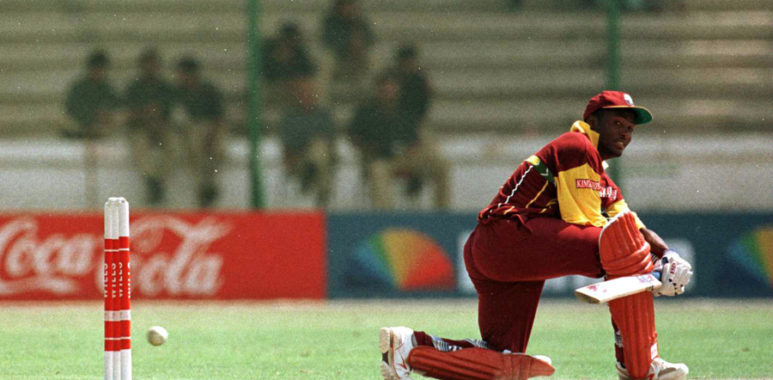
Match Preview Australia vs West Indies, 1996 World Cup, 2nd SF 2020
For our latest #RetroLive match, we rewind to March 1996, and a classic World Cup semi-final between Australia and West Indies in Mohali. The sides had had contrasting fortunes in the opening rounds of the tournament, but their recent history pointed towards another thriller.
Big Picture
It would have been hard to fathom a fortnight ago, when they were being humiliated by the part-timers and part-talents of Kenya in Pune, but West Indies now stand on the verge of their fourth World Cup final, having summoned a response to savour after one of the lowest days in their history.
But standing in their way are the players who have already supplanted them as Test cricket’s unofficial world champions, following a tussle for the ages in the Caribbean last spring, and who are doubtless still smarting themselves, after feeling the initial backlash from Richie Richardson and his chastened men in Jaipur last week.
It’s West Indies versus Australia for a place in the World Cup final. The two-times inaugural winners of the tournament, versus the side that came home with the trophy on the last occasion it was staged in the subcontinent, in 1987. It’s become one of the most compelling rivalries in world cricket in recent years – and now it’s been granted another showdown to savour.
West Indies’ standards may be slipping from their matchless peaks of the 1980s, but the individual talents that make up their squad still include some of the most peerless performers the region has ever produced. And there really was only one fitting course of action for such men after they had been rolled aside for 93 in 35.2 overs by Kenya – surely the World Cup’s most shocking result since Australia were toppled by Zimbabwe in 1983.
Sure enough, the skipper Richardson took it upon himself to guard against the unthinkable – elimination before the knockouts – with his matchwinning 93 not out against the Aussies in Jaipur, and then it was over to Brian Lara to blow South Africa aside in their Karachi quarter-final, with the sort of statement innings that only the truest of greats are able to conjure up when the critical moment comes.
Can they repeat the dose with a place in next week’s final in Lahore at stake? West Indies could hardly ask for a more apt opponent to goad them into another statement performance. For these two teams have been at each other’s throats for the past three years – quite literally in the case of Curtly Ambrose’s famous tete-a-tete with Steve Waugh in Trinidad last April. And as cricket’s fading giants seek to reassert themselves after finally being toppled in the Test arena, it seems only right that the team that most observers believe will form the sport’s next great dynasty should have to fight their way through the old guard one more time.
In contrast to their skittish campaign on home soil four years ago, Australia’s path through the tournament to date has been poised and confident. They’ve had their challenges along the way, most notably in their quarter-final against New Zealand, who really should have put 300 on the board after Lee Germon and Chris Harris had added 168 for the fourth wicket. But their settled line-up has found match-winners at every turn – not least Mark Waugh, whose all-round display in their tight victory over India in Mumbai was masterful.
And now, of course, we already know the identity of the team that awaits the victors in Lahore on Sunday. Last night’s shameful scenes in Calcutta may have robbed Sri Lanka of the on-field moment of glory that their endeavours in this tournament have warranted, but they had, to all intents and purposes, trounced the hosts long before Eden Gardens descended into anarchy.
And that is more than Sri Lanka had been able to do in their group-stage fixtures against these two opponents, after both Australia and West Indies chose to forfeit their matches in Colombo due to security concerns. Admittedly West Indies came closer than they might have expected to missing out on the last eight, but the structure of the tournament meant that neither side had any realistic reasons to rue the lost points. Whether they will have riled their snubbed opponents into redoubling their efforts in the final, however, will be a question for another day…
Form guide
(last five completed ODIs, most recent first)
Australia WLWWW
West Indies WWLLW
In the spotlight
He’s the forgotten Waugh no longer. Mark Waugh may have spent the first decade of his professional life in the shadow of his elder twin Steve, but in one-day cricket, he’s at last found the perfect stage for his silken flamboyance to take hold. It was way back in March 1993, against New Zealand in Dunedin, that Australia first experimented with Junior at the top of the ODI batting card. But it was as recently as January this year that the management finally bit the bullet and unleashed him against the new ball on a permanent basis, and they must now be wondering what held them back for so long. Waugh racked up a man-of-the-match-winning 130 in his first outing against Sri Lanka in Perth, a series-sealing 73 in the second B&H final in Sydney, and then came the World Cup itself, in which his returns have transformed his standing in the world game, not to mention his family power-dynamics. He’s racked up three more hundreds and an unbeaten 76 in five games – having scored just four centuries all told in his first 106. Just as Sachin Tendulkar and Sanath Jayasuriya have been liberated in one-day cricket since being pushed up to open, Waugh’s at the vanguard of a new wave of power batting that will surely be this tournament’s most lasting legacy.
Think of Curtly Ambrose and you probably envisage the stares, the menace, the lurking sense of danger that seems to inhabit those signature wristbands as they whir towards the batsman from a cloud-scraping altitude. It’s possible that you overlook the parsimony, the metronomic economy, the death by a thousand dot-balls that seems to come as a by-product of all his other attributes. And yet, as Ambrose has demonstrated, time and time again in this tournament, that ingrained sense of thrift is actually the bedrock of everything he has achieved in the game, and represents West Indies’ most likely means of adding to those inaugural world titles, the second of which was spearheaded by his spiritual forebear Joel Garner. In five matches to date, he’s gleaned eight wickets at 18.00, but at the remarkable economy rate of 3.09 – including four analyses in which he’s gone for less than 30 runs. His most expensive day out was against India – 8-1-41-2 – but even then he bowled both Ajay Jadeja and Navjot Sidhu in his opening burst. Height, pace, accuracy and relentless drive. The batsman who can claim to have the measure of such attributes hasn’t yet been born.
Team news
Their Jaipur loss notwithstanding, Australia have hit upon a settled and successful formula for this campaign, and – injury permitting – there’s no reason to think they’ll be springing any surprises tomorrow. Taylor and M Waugh at the top, Law, Bevan and Healy in the middle, bookending the youth-and-experience engine-room of Ponting and S Waugh. And then an attack led by four front-line bowlers, now that the seam-hitting experience of Paul Reiffel has been preferred to the all-sorts options that Shane Lee had been providing in the earlier stages of the tournament. They’ve got the class to dominate, and the resilience to stay in the game, depending on which version of West Indies turns up tomorrow.
Australia (possible): 1 Mark Taylor (capt), 2 Mark Waugh, 3 Ricky Ponting, 4 Steve Waugh, 5 Stuart Law, 6 Michael Bevan, 7 Ian Healy (wk), 8 Shane Warne, 9 Paul Reiffel, 10 Damien Fleming, 11 Glenn McGrath.
West Indies have been ringing the changes at the top of their order, seemingly as randomly as the shuffling of a pack of cards, but having launched their campaign with Sherwin Campbell and Richie Richardson ensconced at 1 and 2, they seem now to have settled on Shivnarine Chanderpaul and the wicketkeeper Courtney Browne, neither of whom has yet set the tournament alight but who have at least provided some old-school resistance against the new ball, and given Lara and Richardson a chance to thrive in the middle overs. A decision needs to be taken on the identity of the fourth seamer, with Roland Holder deemed surplus to requirements in their quarter-final win over South Africa, and Cameron Cuffy overlooked since the Kenya loss. Ottis Gibson, with two five-wicket hauls in Australia earlier this year, could be ripe for a recall despite an underwhelming tournament so far.
West Indies (possible): 1 Shivnarine Chanderpaul, 2 Courtney Browne (wk), 3 Brian Lara, 4 Richie Richardson (capt), 5 Jimmy Adams, 6 Keith Arthurton, 7 Roger Harper, 8 Ottis Gibson, 9 Ian Bishop, 10 Curtly Ambrose, 11 Courtney Walsh.
Pitch and conditions
Mohali has so far hosted an inaugural ODI against South Africa, as well as a maiden Test that West Indies will doubtless hope counts as a good omen. But this, to all intents and purposes, is the stadium’s true opening night. It is the project of the BCCI president, Inderjit Bindra, and while the man himself admits that there’s some landscaping to be done before its true splendour is revealed, the lush outfield suggests that the pitch itself will have received similar levels of TLC – although there is a covering of live grass on a firm cracked surface which will doubtless encourage the quicks on either side. One slight oddity are the improbably low floodlights, a requirement due to the nearby airfield. Though they’ve been designed according to baseball specifications, there may be a few outfielders hoping not to face too much aerial bombardment in the match’s closing stages.
Stats and trivia
-
West Indies have won five of their previous six World Cup encounters with Australia, including the inaugural final in 1975 and the recent showdown in Jaipur. Their only setback came in Melbourne in 1992, where Australia’s 57-run win in their final group match wasn’t enough to salvage their own campaign, but did mean that Pakistan leapfrogged West Indies into the last four.
-
Brian Lara needs 74 more runs to reach 4000 in ODIs. He will be playing in his 98th match.
-
Mark Taylor needs 48 more runs to reach 3000 in ODIs. He will be playing in his 95th match.
-
Shane Warne is five wickets away from becoming the fifth Australian, behind Craig McDermott, Steve Waugh, Simon O’Donnell and Dennis Lillee, to reach 100 ODI wickets.

